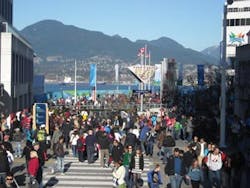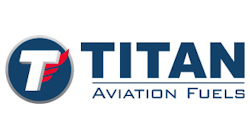Vancouver played host to the 21st Olympic Winter Games in February, the third Olympics ever held in Canada. Aviation service companies across the Western United States and British Columbia prepared for the expected increase in aircraft activity by maintaining strong communication measures with both stakeholders and clients alike. AIRPORT BUSINESS scanned the area and spoke to a variety of fixed base operations on both sides of the border to get a sense of the challenges involved with supporting general aviation during the 2010 Winter Olympic Games.
Stuart Scott of Spokane Airways Flight Center at Spokane International Airport (KGEG) relates that temporary hangar revenue was up 100 percent due entirely to the Olympic event. Spokane, some 250 nautical miles from Vancouver, was one of the closest portal airports to the event.
“Of course, all 2010 Olympic fuel sales were bonus gallons for the month, but average per-aircraft volumes were down by comparison,” says Scott. Three factors specifically affected these particular fuel sales.
First, he explains, the increase in long-range aircraft allowed more ‘tankering’ than usual. “Recognizing that it allowed our customers to control costs at a volatile time, we decided not to establish any minimums partly to create ‘courtesy’ fuel sales, but primarily to confirm that we genuinely believe we are here to serve our customers,” says Scott.
Second, fuel uplifts were calculated on destination and the need to protect slot times, and flight crews sometimes planned for minimal service at KGEG to make up for any unexpected delays enroute.
Third, “Abbotsford (YXX) became, several days into the event, the unofficial but often preferred portal airport based on the reported ability to clear Canadian Customs without being subject to the sometimes long waits at Vancouver International Airport (YVR). “We actually helped customers, originally scheduled to use our FBO, make and confirm arrivals and departures at YXX,” adds Scott.
“Finally, we did see a 20 percent overall increase in fuel volume for the month. Like many ‘special events’, revenues exceeded expenses by a small margin, in this instance 10 percent. The cost of additional manpower combined with the expense of creating an acceptable venue for U.S. CBP (Customs and Border Protection)/TSA screening were the key factors in the additional-expense column.
“The real reward, however, may be priceless ... the re-established relationships, the creation of new partnerships, and first-name familiarity with flight departments has both immediate and long-term value.”
Event planning
Scott says he started planning for the event about three months in advance; around the same time the portal airport working group was put together. The working group included fixed base operations located at portal airports in Canada and the U.S., CBP, FAA, NBAA, CBAA (Canadian Business Aviation Association), fuel providers, and various other stakeholders. The group collaborated to create a website that identified the portal airports, GA security requirements, airport maps, and reservation information.
Overall, Spokane experienced 75 to 100 aircraft during the event. “The big thing for us was if there was a delay, we wanted to be able to call whatever FBO the client was visiting to let it know a new time slot would be scheduled,” remarks Scott. “That was the focus of the website.”
Some aircraft went through security screening at Spokane before dropping passengers off at YVR, and then the pilot would come back and hangar the aircraft for a week, says Scott. “It was really a matter of how many aircraft they could handle at Vancouver at a time.”
TSA and CBP set up specific screening areas within Spokane’s hangars, and a safe area where aircraft could be moved to once the screening was complete, relates Scott. “All passengers had to be screened and put into a holding area,” he explains. “It took about thirty to sixty minutes to screen all passengers and luggage for each aircraft; the process went very smoothly.”
Scott also got assistance from Avfuel, whose director of marketing Marci Ammerman comments, “Because three U.S. airport screening gateways had Avfuel-branded dealers on them, we decided to collaborate and market together.
“Stuart assembled several meetings where we not only met with the FBOs on the stateside, but also all the Canadian FBOs that were involved. We wanted to make the transition and hand-off of aircraft smooth for the pilots and passengers.”
Ammerman says Avfuel used a variety of ways to get information out regarding the event, including social media, print advertising, and web advertising. “Many dealers offered multiple bonus point awards with Avtrip, our proprietary points program based on fuel sales in exchange for U.S. savings bond rewards,” adds Ammerman.
“I think all the dealers saw an increase in fuel sales, which is what we were hoping for.”
Remarks Scott, “We absolutely came away with a profit. Winter is our downtime; normally we would get maybe one aircraft per day, or week … during the event we were getting 10 to 15 aircraft per day. “
A YVR Perspective
Located at Vancouver International, Landmark Aviation general manager Scott Harrold says the Winter Olympics was probably the biggest event for Western Canada that his facility has had to deal with.
“The event consisted of a series of peaks and valleys in terms of aircraft activity,” relates Harrold. “We had a big rush for the opening ceremony; some days we were handling 80 to 90 airplanes, others we only handled 20 to 30.” Landmark worked closely with the CBAA when planning for the event; Harrold currently serves on the CBAA’s board of directors.
Landmark did implement departure fees, which were a cost recovery function for the security aspect, says Harrold. “There was a fair amount of investment made to satisfy Transport Canada and the Canadian Air Transport Security Authority (CATSA) for the screening of passengers.”
The airport reservation system that was in place for the Olympics provided organized slot times — the primary mechanism for arriving to and from YVR. “Every aircraft that came into and out of the Vancouver OCA (Olympic Control Area) required an ISU (Integrated Security Unit) flight authorization number, remarks Harrold. “There were times when we reached capacity at the airport, but in general, NAV Canada and YVR did a fantastic job keeping things moving along regularly.”
After cross-checking revenues with expenses, Harrold says the facility was down when considering the whole event. “Our volumes were down from what we expected; the economy still had a lot to do with the outcome,” he says.
Avoiding security
Remarks Jason Hart, operations manager for Bellingham Aviation Services in Bellingham,WA, “Handling the event was pretty exciting, and also pretty challenging. We have a modest ramp that I share with my competitor; it took some increased organization and a lot of extra hours.”
Bellingham Aviation Services is located at Bellingham International Airport, a port-of-entry airport in the Pacific Northwest. Just 20 miles south of the Canadian border and 50 miles from Vancouver, Bellingham proved a good alternative for those who wanted to avoid extensive Olympics security, says Hart.
“We experienced some 60 jets” he says. In that same period in a typical year, Bellingham might get a half dozen. The FBO sold three times its normal retail fuel flow, relates Hart.
“The challenge was really a ramp space issue,” explains Hart. “We had to make sure we had enough places to actually pull in jets and park them, and then find a way to get the larger jets that we don’t normally move out of the way.
Fuel provider Air BP sent some line staff to help on the ramp for the inaugural date, but for the most part, Hart says he used a lot of in-house overtime.
The Jet Center started planning for the event last fall by working with the Port of Bellingham and another FBO on the field to form a committee that organized and executed the planning efforts, which focused on logistics and ramp space.
Regarding reservation fees, “We had a small per day fee on jets that were parked here, and that was to cover extra insurance costs that we had for the event,” says Hart. The fee was based on aircraft weight and the length of the stay; it ranged from $50 to $150 per day depending on the services provided.
“We were very excited with the level of traffic we received,” relates Hart. “In addition to the fee we implemented, we also experienced an increased level of side services due to the event.
“We got some big catering orders — had half a hockey team on a plane that needed to eat on their way back to Pittsburgh; those types of instances. All in all, revenues went up across the board.”




